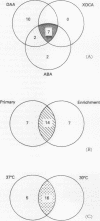Abstract
AIMS: To determine the prevalence of Aeromonas spp in the faeces of children and the association with symptoms of gastroenteritis. METHODS: Faecal specimens (n = 1026) were cultured for Aeromonas spp using three selective media and an enrichment broth at both 30 degrees C and 37 degrees C. The isolation of Aeromonas spp was correlated with symptoms of gastroenteritis, previous antibiotic use, and environmental temperature. RESULTS: Aeromonas spp (n = 28) from 26 (2.5%) patients were recovered. Bile salt, Irgasan, and brilliant green agar was the most efficient selective culture medium. Eleven of the patients had symptoms of gastroenteritis, usually mild diarrhoea of two to three days' duration, in the absence of other recognised enteropathogens. A caviae was a particularly frequent isolate (nine out of 11 cases) in symptomatic individuals. Only one out of seven Aeromonas spp recovered by enrichment culture alone was possibly associated with symptoms of gastroenteritis. There was a close correlation between the environmental temperature and isolation of Aeromonas spp. CONCLUSIONS: Aeromonas spp and particularly A caviae may cause gastroenteritis in children, most often during warmer months of the year. Culture for these potential enteropathogens could be confined to summer and autumn months. Bile salt, Irgasan, and brilliant green selective agar, but not alkaline peptone water enrichment, is an efficient culture medium for recovering possibly clinically important isolates.
Full text
PDF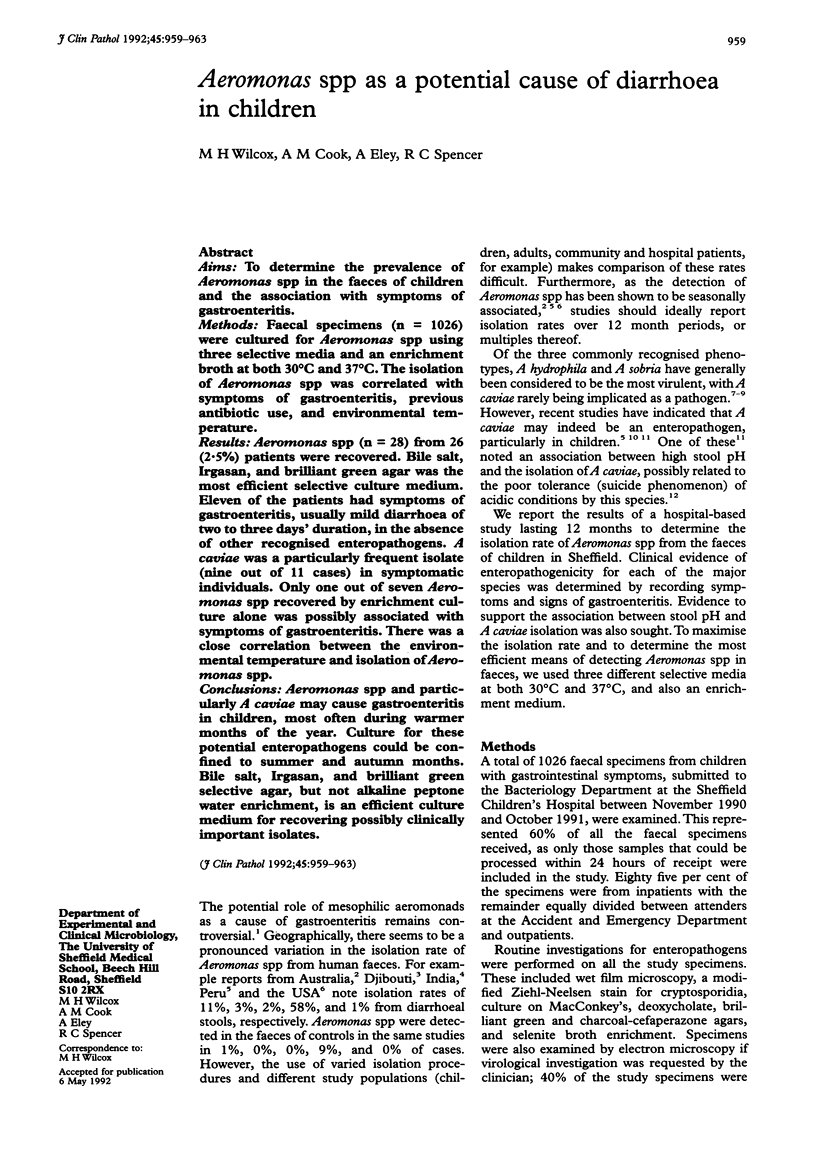
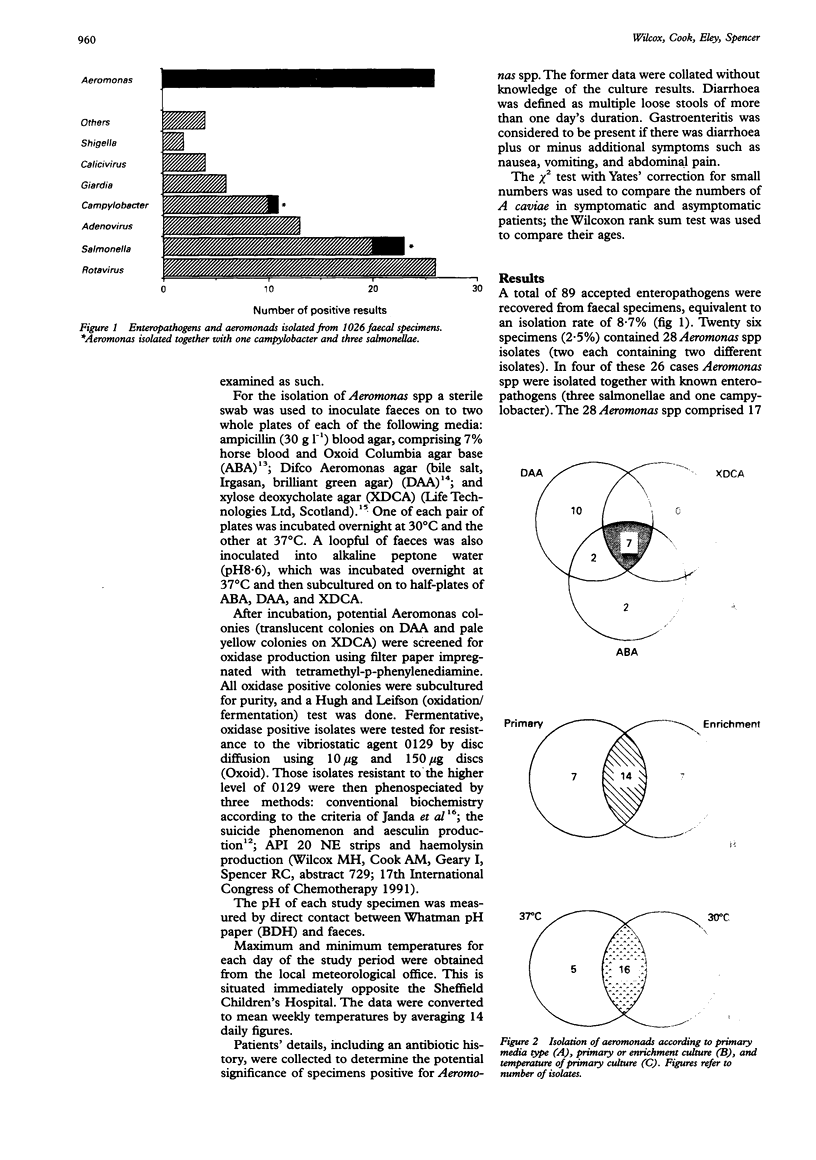
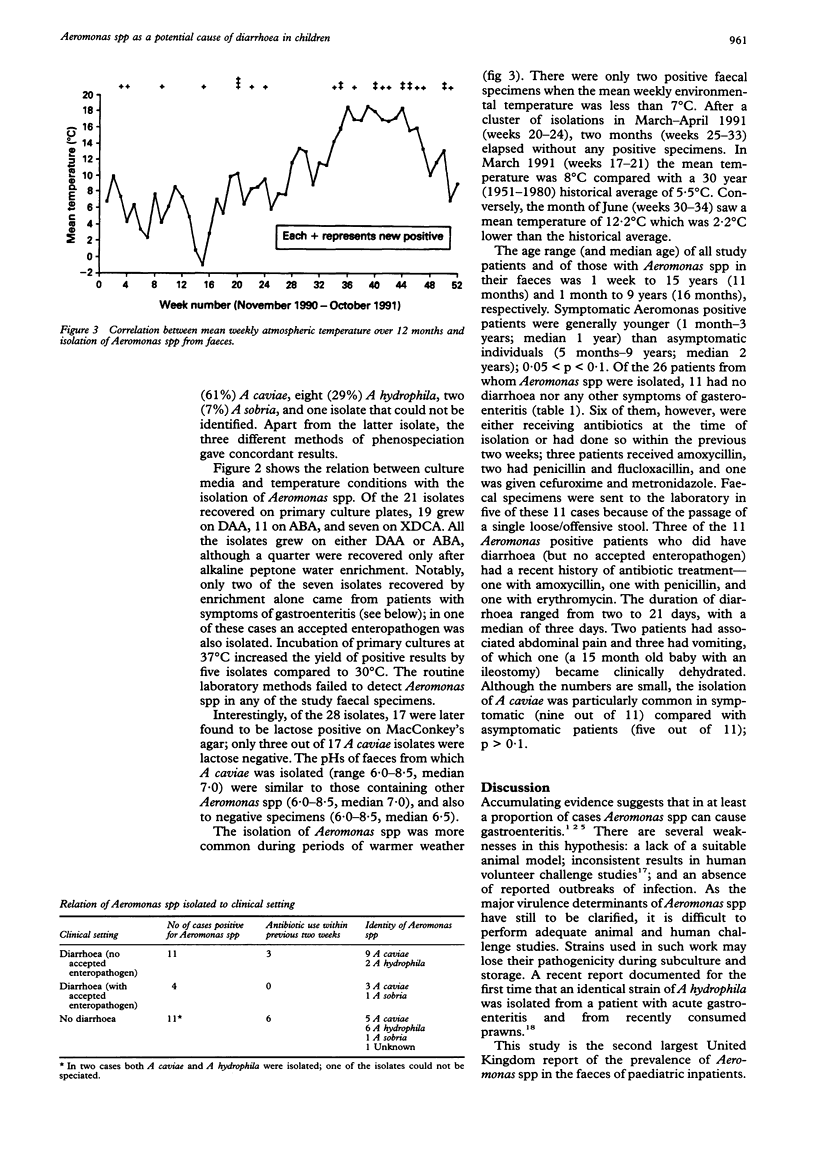
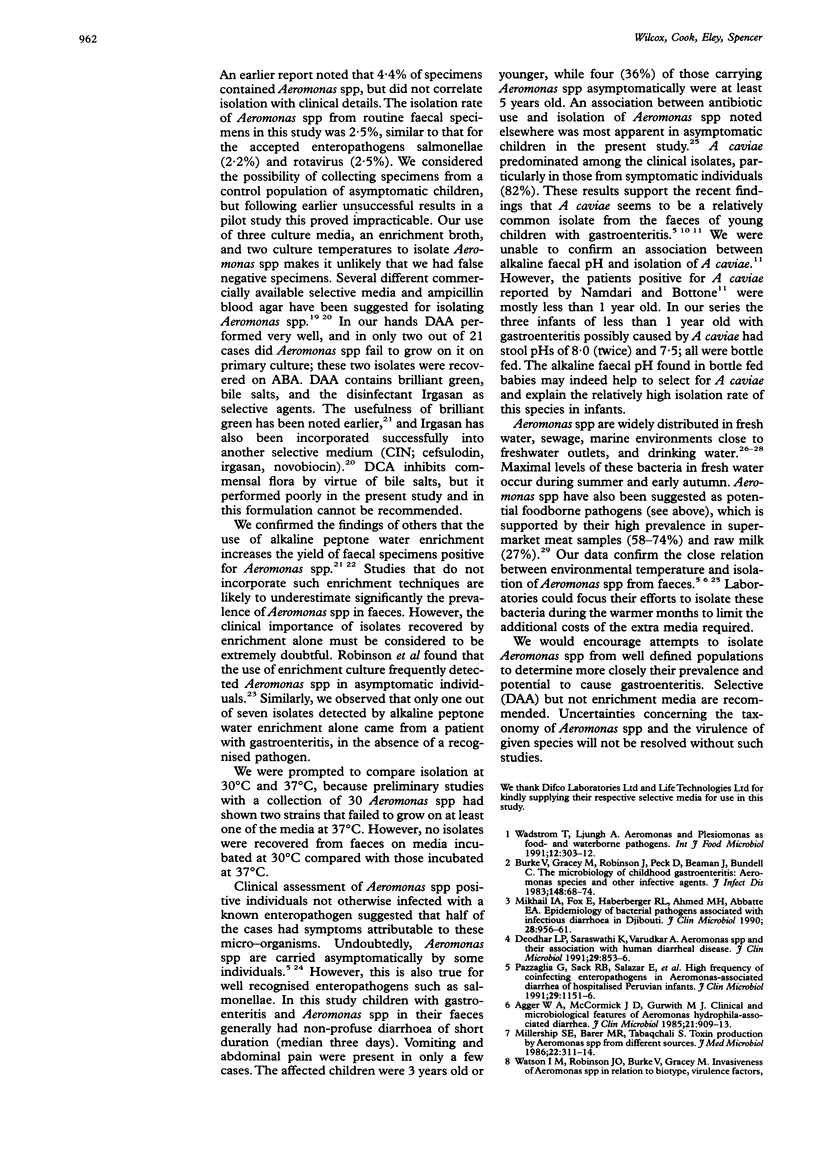
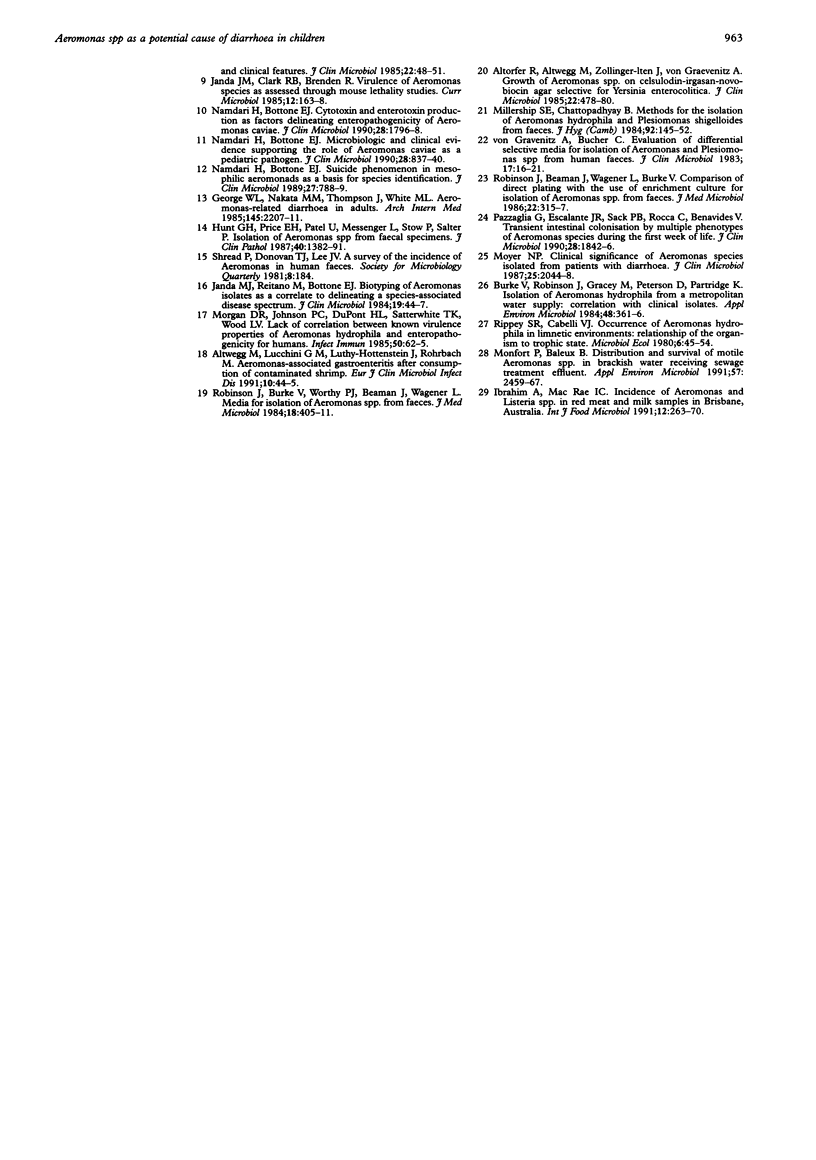
Images in this article
Selected References
These references are in PubMed. This may not be the complete list of references from this article.
- Agger W. A., McCormick J. D., Gurwith M. J. Clinical and microbiological features of Aeromonas hydrophila-associated diarrhea. J Clin Microbiol. 1985 Jun;21(6):909–913. doi: 10.1128/jcm.21.6.909-913.1985. [DOI] [PMC free article] [PubMed] [Google Scholar]
- Altorfer R., Altwegg M., Zollinger-Iten J., von Graevenitz A. Growth of Aeromonas spp. on cefsulodin-Irgasan-novobiocin agar selective for Yersinia enterocolitica. J Clin Microbiol. 1985 Oct;22(4):478–480. doi: 10.1128/jcm.22.4.478-480.1985. [DOI] [PMC free article] [PubMed] [Google Scholar]
- Burke V., Gracey M., Robinson J., Peck D., Beaman J., Bundell C. The microbiology of childhood gastroenteritis: Aeromonas species and other infective agents. J Infect Dis. 1983 Jul;148(1):68–74. doi: 10.1093/infdis/148.1.68. [DOI] [PubMed] [Google Scholar]
- Burke V., Robinson J., Gracey M., Peterson D., Partridge K. Isolation of Aeromonas hydrophila from a metropolitan water supply: seasonal correlation with clinical isolates. Appl Environ Microbiol. 1984 Aug;48(2):361–366. doi: 10.1128/aem.48.2.361-366.1984. [DOI] [PMC free article] [PubMed] [Google Scholar]
- Deodhar L. P., Saraswathi K., Varudkar A. Aeromonas spp. and their association with human diarrheal disease. J Clin Microbiol. 1991 May;29(5):853–856. doi: 10.1128/jcm.29.5.853-856.1991. [DOI] [PMC free article] [PubMed] [Google Scholar]
- George W. L., Nakata M. M., Thompson J., White M. L. Aeromonas-related diarrhea in adults. Arch Intern Med. 1985 Dec;145(12):2207–2211. [PubMed] [Google Scholar]
- Hunt G. H., Price E. H., Patel U., Messenger L., Stow P., Salter P. Isolation of Aeromonas sp from faecal specimens. J Clin Pathol. 1987 Nov;40(11):1382–1384. doi: 10.1136/jcp.40.11.1382. [DOI] [PMC free article] [PubMed] [Google Scholar]
- Janda J. M., Reitano M., Bottone E. J. Biotyping of Aeromonas isolates as a correlate to delineating a species-associated disease spectrum. J Clin Microbiol. 1984 Jan;19(1):44–47. doi: 10.1128/jcm.19.1.44-47.1984. [DOI] [PMC free article] [PubMed] [Google Scholar]
- Mikhail I. A., Fox E., Haberberger R. L., Jr, Ahmed M. H., Abbatte E. A. Epidemiology of bacterial pathogens associated with infectious diarrhea in Djibouti. J Clin Microbiol. 1990 May;28(5):956–961. doi: 10.1128/jcm.28.5.956-961.1990. [DOI] [PMC free article] [PubMed] [Google Scholar]
- Millership S. E., Barer M. R., Tabaqchali S. Toxin production by Aeromonas spp. from different sources. J Med Microbiol. 1986 Dec;22(4):311–314. doi: 10.1099/00222615-22-4-311. [DOI] [PubMed] [Google Scholar]
- Millership S. E., Chattopadhyay B. Methods for the isolation of Aeromonas hydrophila and Plesiomonas shigelloides from faeces. J Hyg (Lond) 1984 Apr;92(2):145–152. doi: 10.1017/s0022172400064159. [DOI] [PMC free article] [PubMed] [Google Scholar]
- Monfort P., Baleux B. Distribution and survival of motile Aeromonas spp. in brackish water receiving sewage treatment effluent. Appl Environ Microbiol. 1991 Sep;57(9):2459–2467. doi: 10.1128/aem.57.9.2459-2467.1991. [DOI] [PMC free article] [PubMed] [Google Scholar]
- Morgan D. R., Johnson P. C., DuPont H. L., Satterwhite T. K., Wood L. V. Lack of correlation between known virulence properties of Aeromonas hydrophila and enteropathogenicity for humans. Infect Immun. 1985 Oct;50(1):62–65. doi: 10.1128/iai.50.1.62-65.1985. [DOI] [PMC free article] [PubMed] [Google Scholar]
- Moyer N. P. Clinical significance of Aeromonas species isolated from patients with diarrhea. J Clin Microbiol. 1987 Nov;25(11):2044–2048. doi: 10.1128/jcm.25.11.2044-2048.1987. [DOI] [PMC free article] [PubMed] [Google Scholar]
- Namdari H., Bottone E. J. Cytotoxin and enterotoxin production as factors delineating enteropathogenicity of Aeromonas caviae. J Clin Microbiol. 1990 Aug;28(8):1796–1798. doi: 10.1128/jcm.28.8.1796-1798.1990. [DOI] [PMC free article] [PubMed] [Google Scholar]
- Namdari H., Bottone E. J. Microbiologic and clinical evidence supporting the role of Aeromonas caviae as a pediatric enteric pathogen. J Clin Microbiol. 1990 May;28(5):837–840. doi: 10.1128/jcm.28.5.837-840.1990. [DOI] [PMC free article] [PubMed] [Google Scholar]
- Namdari H., Bottone E. J. Suicide phenomenon in mesophilic aeromonads as a basis for species identification. J Clin Microbiol. 1989 Apr;27(4):788–789. doi: 10.1128/jcm.27.4.788-789.1989. [DOI] [PMC free article] [PubMed] [Google Scholar]
- Pazzaglia G., Escalante J. R., Sack R. B., Rocca C., Benavides V. Transient intestinal colonization by multiple phenotypes of Aeromonas species during the first week of life. J Clin Microbiol. 1990 Aug;28(8):1842–1846. doi: 10.1128/jcm.28.8.1842-1846.1990. [DOI] [PMC free article] [PubMed] [Google Scholar]
- Pazzaglia G., Sack R. B., Salazar E., Yi A., Chea E., Leon-Barua R., Guerrero C. E., Palomino J. High frequency of coinfecting enteropathogens in Aeromonas-associated diarrhea of hospitalized Peruvian infants. J Clin Microbiol. 1991 Jun;29(6):1151–1156. doi: 10.1128/jcm.29.6.1151-1156.1991. [DOI] [PMC free article] [PubMed] [Google Scholar]
- Robinson J., Beaman J., Wagener L., Burke V. Comparison of direct plating with the use of enrichment culture for isolation of Aeromonas spp. from faeces. J Med Microbiol. 1986 Dec;22(4):315–317. doi: 10.1099/00222615-22-4-315. [DOI] [PubMed] [Google Scholar]
- Robinson J., Burke V., Worthy P. J., Beaman J., Wagener L. Media for isolation of Aeromonas spp. from faeces. J Med Microbiol. 1984 Dec;18(3):405–411. doi: 10.1099/00222615-18-3-405. [DOI] [PubMed] [Google Scholar]
- Wadström T., Ljungh A. Aeromonas and Plesiomonas as food- and waterborne pathogens. Int J Food Microbiol. 1991 Apr;12(4):303–311. doi: 10.1016/0168-1605(91)90144-e. [DOI] [PubMed] [Google Scholar]
- von Graevenitz A., Bucher C. Evaluation of differential and selective media for isolation of Aeromonas and Plesiomonas spp. from human feces. J Clin Microbiol. 1983 Jan;17(1):16–21. doi: 10.1128/jcm.17.1.16-21.1983. [DOI] [PMC free article] [PubMed] [Google Scholar]




